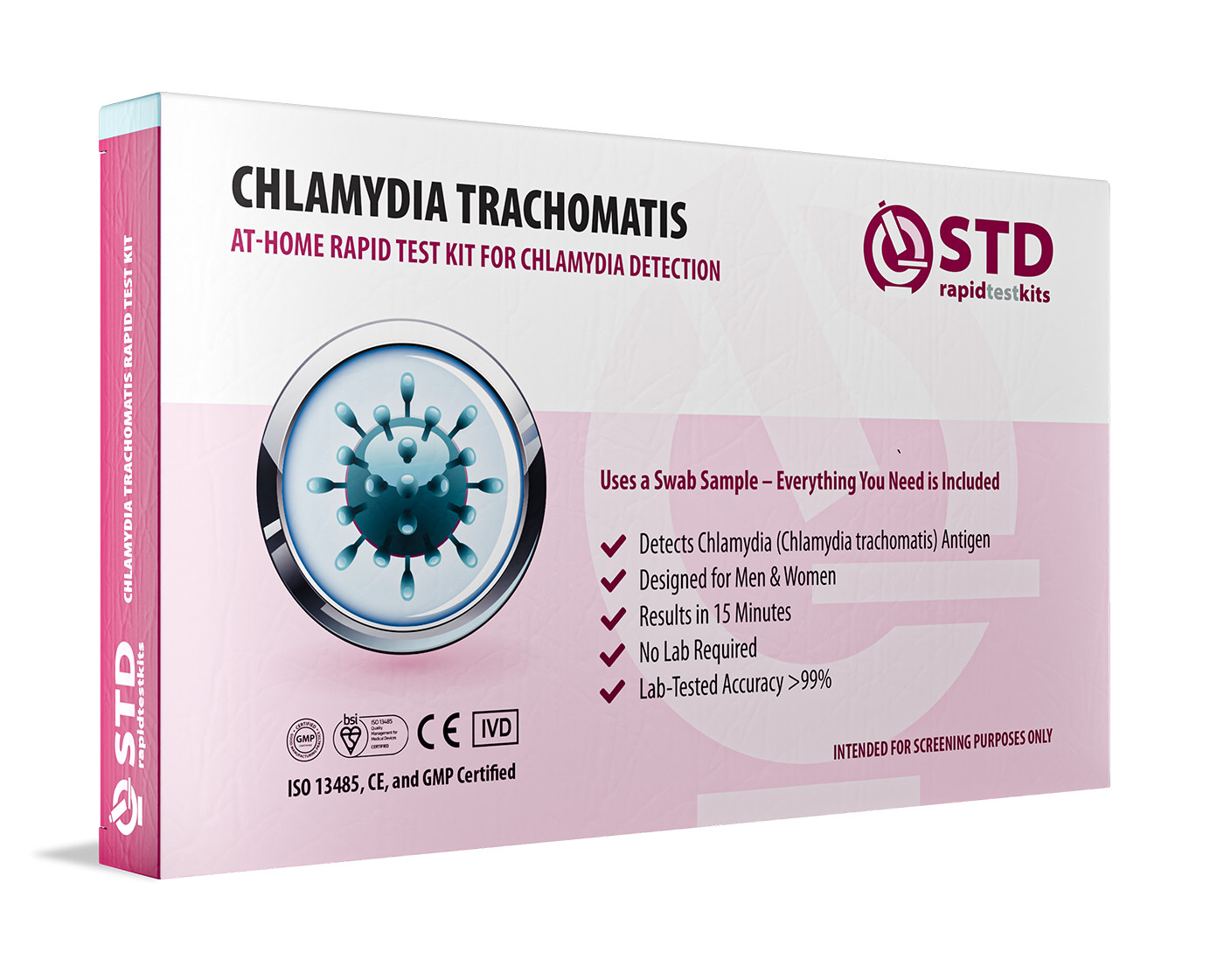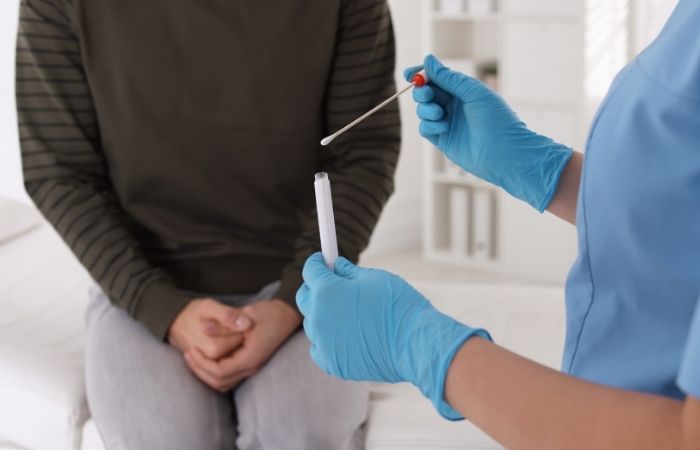I Had Symptoms but Was Too Embarrassed to Go to a Clinic, These Tests Helped
Why Gonorrhea in Men Is Still a Major Public Health Threat
Gonorrhea is not some fringe disease hiding in the shadows, it’s one of the most commonly reported STIs in the world. The World Health Organization estimates over 82 million new cases globally every year. In the U.S. alone, the CDC reports over 700,000 new infections annually, and that number keeps rising. So why does it still fly under the radar? One word: denial.
Men often don’t recognize the early signs. Or they chalk them up to irritation from tight underwear, a long bike ride, dehydration, anything but an STD. And when symptoms are brushed off, gonorrhea doesn’t just fade into the background. It festers. It spreads. It causes real, irreversible damage.
Gonorrhea primarily infects the urethra, but that’s just its launchpad. If left untreated, it can travel to the testicles, prostate, rectum, and even the bloodstream, causing a condition called disseminated gonococcal infection (DGI), a rare but life-threatening complication.
Even scarier? Antibiotic resistance is making gonorrhea harder to treat than ever. The CDC has officially labeled it a “superbug in the making.” So yes, we need to talk about the symptoms. But more importantly, we need to listen to them when they show up.

9 Gonorrhea Symptoms in Men You Should Never Ignore
Penile Discharge (AKA “The Clap Drip”)
This is the signature symptom. Classic gonorrhea discharge is thick, cloudy, and often yellow, green, or white. It can leak out of the penis tip like pus from a wound, especially in the morning, hence the nickname "the morning drip." Many guys first notice it when pulling down their boxers and seeing a crusty stain or a slimy residue. If it smells funky? Even more reason to panic.
- What it feels like: Embarrassing, sticky, and impossible to unsee.
- Why it matters: Indicates active infection of the urethra, and you’re highly contagious.
Burning or Pain During Urination
That telltale sting when you pee is not something to brush off. It’s called dysuria, and it's caused by inflammation of the urethral lining. It can range from a mild tingle to a full-on razor-blade burn.
- What it feels like: Like peeing acid, especially during the first few seconds.
- Why it matters: This is often the first symptom men notice, and one of the most commonly ignored.
Frequent Urge to Urinate
Gonorrhea can mimic a urinary tract infection (UTI), even though UTIs are far less common in men. If you're suddenly visiting the bathroom every 30 minutes and producing only a trickle, this could be a sign that gonorrhea is inflaming your urethra.
- What it feels like: The constant need to go… with nothing to show for it.
- Why it matters: This symptom often leads doctors to misdiagnose or overlook STIs altogether.
Check Your STD Status in Minutes
Test at Home with RemediumChlamydia Test Kit

 For Men & Women
For Men & Women Results in Minutes
Results in Minutes No Lab Needed
No Lab Needed Private & Discreet
Private & DiscreetOrder Now $33.99 $49.00
Testicular Pain or Swelling
When the infection spreads beyond the urethra, it can cause epididymitis, an inflammation of the tube behind the testicles that carries sperm. This can cause one or both testicles to swell, ache, or feel heavy.
- What it feels like: Dull ache, pressure, or outright pain in the scrotum.
- Why it matters: Left untreated, this can lead to infertility. Yes, permanent.
Itching or Irritation Inside the Penis
This one’s sneaky. It doesn’t feel like a rash or a burn, more like an annoying, internal itch. Something’s off, but it’s hard to pinpoint. Many men write it off as friction, dryness, or over-washing.
- What it feels like: A subtle itch or crawl inside the urethra.
- Why it matters: A classic symptom of early urethral inflammation. Don’t ignore it.
Anal Discomfort (Even Without Anal Sex)
Men who receive anal sex may develop rectal gonorrhea, but you can also spread the bacteria by touching your genitals and then the anal area. Symptoms include discharge, pain during bowel movements, or an itchy rectum.
- What it feels like: Soreness, mucous-streaked stool, or anal itching.
- Why it matters: Rectal gonorrhea is often asymptomatic but highly infectious.

Throat Pain or Sore Throat
Oral gonorrhea is real, and rising. If you’ve had unprotected oral sex (receiving or giving), you could develop gonorrhea in your throat. It often looks like tonsillitis, with redness, white spots, or persistent soreness.
- What it feels like: Scratchy throat, difficulty swallowing, or swollen glands.
- Why it matters: Throat gonorrhea is frequently missed, but still transmissible.
Conjunctivitis (Yes, In Your Eyes)
Touch your genitals, then your eye? Boom, you might just infect your eyeball. Gonorrheal conjunctivitis causes redness, discharge, and severe eye irritation.
- What it feels like: Sticky eyelids, pain, and yellow discharge.
- Why it matters: Eye infections from gonorrhea can permanently damage vision if untreated.
No Symptoms At All (The Silent Spread)
Here’s the kicker: up to 50% of men with gonorrhea are completely asymptomatic. No burning, no drip, no clue, but still spreading it to every partner.
- What it feels like: Absolutely nothing, until the complications set in.
- Why it matters: Asymptomatic carriers are the primary drivers of STI epidemics.
Check Your STD Status in Minutes
Test at Home with RemediumChlamydia & Gonorrhea Test

 For Men & Women
For Men & Women Results in Minutes
Results in Minutes No Lab Needed
No Lab Needed Private & Discreet
Private & DiscreetOrder Now $49.00 $98.00
For all 2 tests
The Consequences of Ignoring Gonorrhea in Men
It’s tempting to wait it out. Maybe it’s just irritation. Maybe it’ll go away on its own. But here’s the cold truth: gonorrhea doesn’t forgive delay. The longer it’s left untreated, the higher the risk of serious complications, not just for you, but for everyone you sleep with.
Infertility and Testicular Damage
Gonorrhea can spread to the epididymis, a coiled tube behind each testicle that stores and carries sperm. When infected, this structure becomes inflamed and painful, a condition called epididymitis. Left unchecked, the inflammation can scar or block the passage of sperm, leading to infertility.
This isn’t just hypothetical. Men have ended up permanently sterile from untreated gonorrhea, all because they ignored that low ache in their groin for too long.
Chronic Prostatitis
If the infection spreads upward, it can infect the prostate gland, resulting in chronic pelvic pain, painful ejaculation, and even urinary retention. The prostate is a sensitive, hormone-responsive organ. When it becomes inflamed, it can wreak havoc on your sex life and your comfort.
Disseminated Gonococcal Infection (DGI)
In rare cases, gonorrhea bacteria escape into the bloodstream. This condition, known as DGI, can cause:
- Skin lesions
- Joint pain and swelling
- Fever
- Septic arthritis
- Life-threatening infections of the heart or brain
DGI is uncommon but extremely dangerous, and it disproportionately affects men who go untreated for weeks or months.
Increased Risk of HIV Transmission
If you have gonorrhea, your chances of getting or transmitting HIV go way up. Gonorrhea causes inflammation and small tears in the genital lining, which makes it easier for HIV to enter your system, or be passed to someone else.
In other words, gonorrhea doesn’t just mess with your urinary tract. It opens the door to much bigger problems.

What to Do If You Suspect Gonorrhea
If any of the symptoms we’ve talked about sound familiar, here’s your next move: get tested. Immediately. The faster you know, the faster you can get treated, and the better your outcome will be.
How Testing Works
For men, gonorrhea testing usually involves:
- A urine test to detect urethral infections
- A swab of the throat, rectum, or eye if there are symptoms in those areas
You don’t need a referral or a trip to a clinic. Thanks to STD Rapid Test Kits, you can test for gonorrhea at home, no judgment, no awkward questions, no waiting rooms. Just discreet packaging, accurate results, and peace of mind.
The Cure (Yes, There Still Is One)
Despite growing antibiotic resistance, most cases of gonorrhea can still be cured with a one-time intramuscular injection of ceftriaxone. Your doctor may also prescribe oral antibiotics like azithromycin or doxycycline if co-infection with chlamydia is suspected.
Important: never try to self-medicate or rely on expired antibiotics. That’s a one-way ticket to drug-resistant infection.
Order Now $69.00 $147.00 Check Your STD Status in Minutes
Test at Home with Remedium
3-in-1 STD Test Kit




For all 3 tests
What the Experts Are Saying
Dr. Emily Austin, infectious disease specialist at Johns Hopkins, puts it bluntly:
“Gonorrhea isn’t just a nuisance, it’s a reproductive health crisis waiting to happen. We’re seeing more men with advanced complications, especially those who waited too long to get tested because they were embarrassed.”
Case in point: “Tony,” a 27-year-old grad student, noticed discharge and burning when he peed. He ignored it for a week. Then his left testicle swelled to the size of a lemon. Emergency ultrasound revealed epididymitis. After antibiotics and rest, he recovered, but his fertility may be permanently reduced.
“I thought it was just irritation from sex,” he said. “I wish I’d gotten tested right away.”
In another case, a 31-year-old software engineer in San Diego developed a sore throat and joint pain. He assumed it was a cold. It turned out to be DGI. By the time he was diagnosed, the bacteria had entered his bloodstream. He was hospitalized for 8 days.
Gonorrhea doesn’t discriminate. And it doesn’t wait for you to be ready.
Gonorrhea in History, From Ancient Shame to Modern Superbug
Let’s time travel. Gonorrhea isn’t new, not even close. References to a mysterious “dripping disease” go back to ancient Egyptian and Greek medical texts. The name “gonorrhea” itself comes from Greek: gonos meaning “seed” and rhoe meaning “flow”, a reference to the seminal-like discharge from the penis. Spoiler: it wasn’t semen. It was pus. And it was highly contagious.
The Clap: A Medieval Misunderstanding
The infamous nickname “the clap” likely originated in the 1500s from brothels in Paris, known as “les clapiers” (rabbit warrens). Another theory? Men with discharge were told to “clap” their penis between heavy books or their hands to expel the fluid. (Do not try this. Seriously.)
Before antibiotics, gonorrhea was managed with medieval treatments like mercury, cauterization, and herbal suppositories. Unsurprisingly, they didn’t work, and often caused more harm than the disease itself.
Enter Penicillin, and the False Sense of Security
In the 1940s, penicillin changed everything. Gonorrhea became treatable, even curable. But this “miracle drug” also led to a dangerous misconception: that STDs were no big deal anymore.
Fast forward to today, and that illusion is cracking. Drug-resistant gonorrhea is now a global public health emergency, with some strains shrugging off multiple lines of antibiotics. We’ve come full circle: a once-conquered disease is now mutating faster than we can treat it. And still, too many men aren’t paying attention, until it’s too late.

What’s Next? The Future of Gonorrhea Treatment and Prevention
The bad news? Gonorrhea is getting smarter. The good news? So are we.
New Diagnostic Tools
Rapid, point-of-care tests are being developed that can detect gonorrhea and determine antibiotic resistance in under 30 minutes. This could revolutionize STI care, especially in resource-limited areas or for people too embarrassed to visit a clinic.
Vaccines on the Horizon
Researchers are currently testing vaccines to prevent gonorrhea. One promising candidate is a meningitis B vaccine that showed partial protection against gonorrhea in early studies. If successful, this could be a game-changer for at-risk populations.
App-Based Sexual Health
Telehealth platforms and at-home test kits from providers like STD Rapid Test Kits are making it easier than ever to get tested without the shame. You order online, test at home, and get results, no awkward clinic visits, no raised eyebrows. The future of gonorrhea prevention isn’t just about medicine. It’s about access, anonymity, and accountability.
What You Can Do Today, Practical Steps to Protect Yourself
It’s not enough to read about gonorrhea. You need to act on it. Here's how:
Get Tested Regularly
If you’re sexually active, especially with new or multiple partners, test every 3–6 months. STIs like gonorrhea are often symptomless, so don’t wait for a sign. Prevention is power.
Use Protection (Every Time)
Condoms and dental dams aren’t perfect, but they significantly reduce your risk. Don’t skip them just because things “seem safe.” Remember: no symptoms ≠ no infection.
Talk to Your Partners
It’s awkward, but essential. A simple “When was your last STI test?” can protect both of you. Normalize the conversation. You’re not paranoid, you’re responsible.
Order At-Home Tests
Don’t want to face a clinic? STD Rapid Test Kits offers discreet, medically approved testing kits shipped directly to your door. No excuses, no shame.
Don’t Self-Treat
Never Google your way into taking leftover antibiotics. Not only is it dangerous, it fuels antibiotic resistance. Always get a confirmed diagnosis and follow your provider’s treatment plan precisely.
Order Now $149.00 $392.00 Check Your STD Status in Minutes
Test at Home with Remedium
8-in-1 STD Test Kit




For all 8 tests
Real Voices, Personal Stories of Gonorrhea Survival
Sometimes statistics and symptoms aren’t enough. Sometimes it takes hearing from someone who’s been there.
Marcus, 24, “I Thought It Was Razor Burn”
“I noticed an itchy sensation and a slight sting when I peed. I figured it was razor burn from trimming down there. A week later, there was discharge. I panicked, Googled it, and knew it was gonorrhea. I used an at-home test kit because I was too embarrassed to go to a clinic. It was positive. I got treated quickly and told my ex, turns out, they were asymptomatic. I could’ve passed it to someone else without ever knowing.”
Jamal, 30, “It Hit Me in the Joints”
“I didn’t even have discharge. Just some throat soreness. I thought it was allergies. Then my knees and fingers started swelling. The ER doctor said it was DGI, gonorrhea in my bloodstream. I needed IV antibiotics for 5 days. I had no idea gonorrhea could do that. I was lucky I went in when I did.”
Tyler, 21, “The Guilt Was Worse Than the Symptoms”
“I hooked up a few times in college and didn’t use protection. When I got diagnosed, I felt disgusted with myself. I thought I had ruined my chances of being a good partner. But my nurse reminded me this is common, treatable, and doesn’t make me dirty, it makes me human. That helped more than the meds.”
These stories aren’t rare. They’re happening in every city, on every campus, and in every age group. And they all point to the same truth: gonorrhea thrives in silence. But knowledge kills the shame.
FAQs
1. Can gonorrhea cure itself without antibiotics?
No. It won’t resolve on its own and can cause lasting damage.
2. I had protected sex but gave oral, can I still get it?
Yes. Gonorrhea can be transmitted via oral sex even with a condom during intercourse.
3. How soon after exposure do symptoms appear?
Usually within 2–7 days, but sometimes it takes longer, or symptoms never appear.
4. Can I test for gonorrhea at home?
Absolutely. Services like STD Rapid Test Kits offer private, accurate, mail-in testing.
5. Does discharge mean I definitely have it?
Discharge is a major sign, but it could also indicate chlamydia or UTIs. Only a test can confirm.
6. Can I spread it through kissing?
It’s rare, but possible if there’s an active oral infection.
7. Will my doctor judge me?
No, or they shouldn’t. STI care is routine, and doctors are trained to handle it without stigma.
8. Can I get it from a toilet seat?
Nope. Gonorrhea dies quickly outside the body and is not spread through casual contact.
9. How long do I have to wait after treatment to have sex again?
Wait at least 7 days after treatment, and only resume sex if your partner has been treated too.
10. What happens if I get gonorrhea more than once?
Reinfection is common. There’s no immunity, so test and protect yourself regularly.

Take the Hint, Don’t Ignore the Drip
Here’s the reality: your body whispers long before it screams. That tiny sting when you pee? That crusty morning drip? That barely-there itch? They’re all potential warning shots, and gonorrhea isn’t bluffing.
Whether you’re sexually active with one partner or many, you’re not immune. You’re not gross. You’re not irresponsible for catching an STI. But you are responsible for what you do next. So here’s your move: don’t guess, test.
You can go to a clinic. You can talk to your doctor. Or you can skip the awkward stares and order an at-home gonorrhea test kit today from STD Rapid Test Kits. It’s fast. It’s private. And it’s how you take back control.
Because what gonorrhea looks like in men isn’t just discharge and pain. It looks like silence. It looks like shame. And it only wins when you pretend not to see it. But now you do.
Sources
1. Mayo Clinic – Gonorrhea: Symptoms & Causes
2. Healthline – Gonorrhea: Symptoms, Treatment & More
3. Cleveland Clinic – Gonorrhea Overview
4. Teen Vogue – Drug-Resistant Gonorrhea Warning










